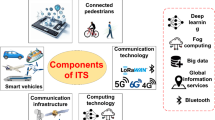Abstract
A hierarchical group location tracking (HGLT) based on grouplocation tracking and hierarchical location update is proposed toreduce the location management cost for terrestrialtransportation systems (TSs) in personal communication networks. A global group location update (GGLU) and a local group locationupdate (LGLU) are performed to provide an accurate position for auser. The GGLU informs a virtual visitor location register of thecurrently camped-on location area and the LGLU informs the servingmobile switching center of the currently camped-on cell. Althoughthe LGLU is done each time a TS moves into a new cell, it causessmall increment in the signaling cost due to localized updates andgroup updates compared with the previous group location trackingscheme. The proposed scheme significantly reduces the paging costbecause the scheme pages only a camped-on cell using the LGLUinformation. Compared with the previous schemes, the HGLT reducesthe location management cost, and it is more efficient as thecost for paging a cell increases.
Similar content being viewed by others
References
Seshardri Mohan and Ravi Jain, “Two User Location Strategies for Personal Communication Services”, IEEE Personal Commun., Vol. 1, No. 1, pp. 42-50, First Quarter 1994.
EIA/TIA, “Cellular Radio-Telecommunications Intersystem Operations”, EIA/TIA, Tech. Rep. IS-41 Revision C, 1995.
I.F. Akyildiz, J. Mcnair, J.S.M. Ho, H. Uzunalio?u and W. Wang, “Mobility Management in Next-Generation Wireless Systems”, Proc. of IEE, Vol. 87, No. 8, pp. 1347-1384, 1999.
R. Jain, Y.B. Lin and S. Mohan, “A Caching Strategy to Reduce Network Impacts of PCS”, IEEE J. Select. Areas Commun., Vol. 12, No. 8, pp. 1434-1444, 1994.
N. Shivakumar and J. Widom, “User Profile Replication for Faster Location Lookup in Mobile Communications”, Proc. ACM/IEEE MOBICOM'95, pp. 161-169, 1995.
R. Jain and Y.B. Lin, “An Auxiliary User Location Strategy Employing Forwarding Pointers to Reduce Network Impact of PCS”, ACM-Baltzer J. Wireless Networks, Vol. 1, No. 2, pp. 197-210, 1995.
K.L. Sue and C.C. Tseng, “One-Step Pointer Forwarding Strategy for Location Tracking in Distributed HLR Environment”, IEEE J. Selected Areas in Commun., Vol. 15, No. 8. pp. 1455-1466, 1997.
Joseph S.M. Ho and I.F. Akyildiz, “Local Anchor Scheme for Reducing Signaling Costs in Personal Communications Networks”, ACM-Baltzer Trans. Networking, Vol. 4, No. 5, pp. 709-725, 1996.
I. Han and D.H. Cho, “Group Location Tracking Based on Representative Identity and Virtual VLR for Transportation Systems”, IEEE Commun. Letter, Vol. 5, No. 8, pp. 349-351, 2001.
Il Han, Seung-Sik Choi and Dong-Ho Cho, “Group Location Management for Transportation Systems in Wireless Systems”, VTC 2001 Fall, Vol. 4, pp. 2726-2730, 2001.
I.F. Akyildiz and J.S.M. Ho, “A Mobile User Location Update and Paging Mechanism Under Dela Constraints”, ACM SIGCOMM'95 Conference, Boston, pp. 244-255, 1995.
A. Pashtan and I.A. Cimet, “The CLU Mobility Management Scheme for Digital Cellular Systems”, IEEE 46th VTS, U.S.A., Vol. 3, pp. 1873-1877, 1996.
Author information
Authors and Affiliations
Rights and permissions
About this article
Cite this article
Han, I., Cho, DH. Hierarchical Group Location Tracking for Transportation Systems in Wireless Personal Communication Networks. Wireless Personal Communications 26, 17–31 (2003). https://doi.org/10.1023/A:1025391627727
Issue Date:
DOI: https://doi.org/10.1023/A:1025391627727




